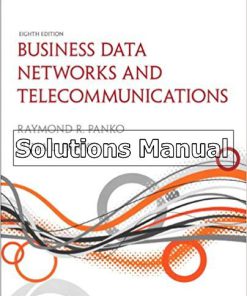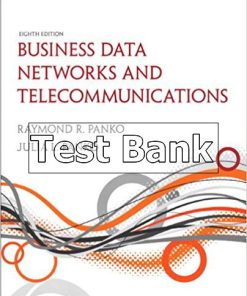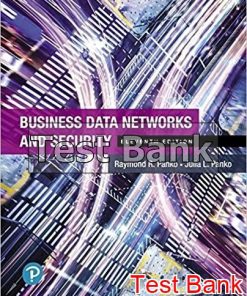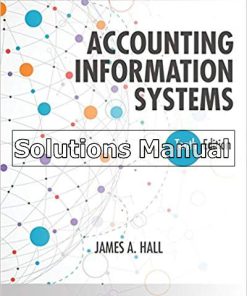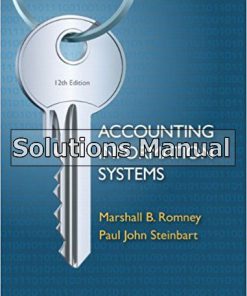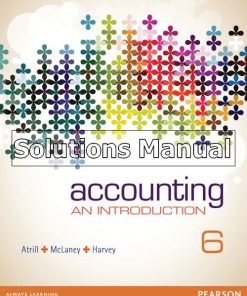Business Data Networks and Security 11th Edition Panko Solutions Manual
$26.50$50.00 (-47%)
Business Data Networks and Security 11th Edition Panko Solutions Manual.
You may also like
Business Data Networks and Security 11th Edition Panko Solutions Manual
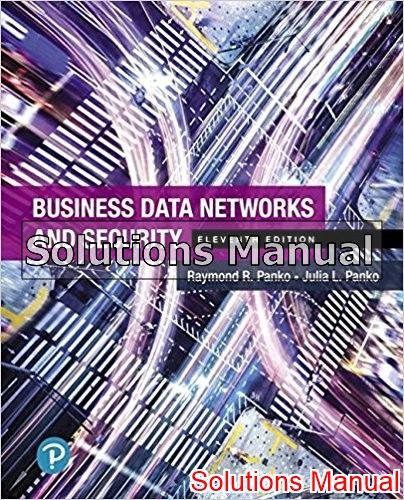
Product details:
- ISBN-10 : 0134817125
- ISBN-13 : 978-0134817125
- Author: Ray Panko
With a clear writing style and a focus on contemporary technologies, Business Data Networks and Security guides readers through the details of networking, while effectively training them for the demands of the modern workplace. Authors Panko and Panko start with the basics –including the Internet, security, and network design – and move on to the latest in networking techniques and wireless networking, all while emphasizing security. The 11th Edition helps readers form a firm foundation, including sound job-related training, in the context of the latest updates and advances in the field.
Table contents:
- Chapter 1 Core Network Concepts and Terminology
- Learning Objectives
- A State of Siege1
- Anything, Anytime, Anywhere
- Test Your Understanding
- The Internet Reorganizes to Get Commercial
- Internet Service Providers
- Hosts
- E-Commerce
- Test Your Understanding
- Old Yet Always New
- No Longer New?
- Growing Speed
- Growing Ubiquity and Reliability
- The Emerging Internet of Everything
- Test Your Understanding
- Owning and Managing the Internet
- Test Your Understanding
- The Snake in the Garden
- Test Your Understanding
- Next Steps
- Test Your Understanding
- Outside the Internet
- Test Your Understanding
- Client and Server Hosts
- Client Hosts
- Server Hosts
- Test Your Understanding
- Networked Applications
- Test Your Understanding
- The Job of the Source Host
- Sending Short Application Messages
- The Final IP Packet
- Sending Long Application Messages
- Test Your Understanding
- The Job of the Destination Host
- Freeing the Application Program from Networking Details
- Test Your Understanding
- Inside the Internet
- The Main Characters: IP Addresses, Packets, Routers, Data Links, and Routes
- IP Addresses
- Binary to Decimal
- Decimal to Binary
- IP Version 6 Addresses
- Test Your Understanding
- IP Packets
- Test Your Understanding
- Routers
- Routing
- On Router B
- Test Your Understanding
- Data Links and Routes
- Test Your Understanding
- The Transport and Internet Processes in the Network Stack
- Test Your Understanding
- Supervisory Standards: Beyond TCP and IP
- Supervisory Protocols
- Test Your Understanding
- Dynamic Host Configuration Protocol (DHCP)
- Test Your Understanding
- Domain Name System (DNS)
- Test Your Understanding
- Single Networks, Data Links, and Physical Links
- Point-to-Point Single Networks
- Test Your Understanding
- Ethernet Single Networks
- Ethernet Frames and Data Links
- Ethernet Physical Links (versus PPP Physical Links)
- Test Your Understanding
- Frames and Packets
- Test Your Understanding
- Single Network Addresses
- Test Your Understanding
- Internet Routers and Personal Access Routers
- Internet Core Routers
- Residential Access Router
- Corporate Access Point
- Test Your Understanding
- Where to Next?
- End-of-Chapter Questions
- Thought Questions
- Perspective Questions
- Chapter 1a Hands-On: A Few Internet Tools
- Learning Objectives
- Hands-On Exercises
- Chapter 2 Network Standards
- Learning Objectives
- How Internet Standards Come to Be
- Introduction
- Standard = Protocol
- What Are Network Standards?
- The Importance of Standards
- Test Your Understanding
- Creating Standards
- Standards Agencies
- Test Your Understanding
- Standards Architectures
- Layering
- Specialization in Design
- Changing a Single Layer
- Test Your Understanding
- The OSI Standards Architecture
- The TCP/IP Standards Architecture
- When Do We Capitalize “Internet?”
- The Hybrid TCP/IP–OSI Standards Architecture
- Application Standards
- Test Your Understanding
- The Five Layers
- Test Your Understanding
- Repeated Concepts at Layers 2 and 3
- Packets Are Carried Inside Frames
- Test Your Understanding
- Message Ordering (Plus Reliability and Connection Orientation) in Standards
- Simple Message Ordering in HTTP
- Test Your Understanding
- Message Ordering and Reliability in TCP at the Transport Layer
- Connections
- TCP Segments
- The Three-Step Opening
- Control Segments
- Test Your Understanding
- Sequence Numbers
- Test Your Understanding
- Carrying Application Data
- Reliability
- Test Your Understanding
- The Four-Step Closing
- Test Your Understanding
- Message Syntax in Standards
- Syntax: General Message Organization
- Data Fields, Headers, and Trailers
- Fields
- Test Your Understanding
- The Syntax of the Internet Protocol (IP) Packet
- 32 Bits per Row
- Source and Destination IP Address Fields
- Unreliability
- A Connectionless Protocol
- Test Your Understanding
- Transmission Control Protocol (TCP) Segment Syntax
- Fields in TCP/IP Segments
- Flag Fields
- Sequence Numbers
- Acknowledgment Numbers
- Dual-Purpose Segments
- Test Your Understanding
- User Datagram Protocol (UDP) Datagram Syntax
- Test Your Understanding
- Port Numbers
- Server Port Numbers
- Client Port Numbers
- Sockets
- Test Your Understanding
- Frame Syntax
- Octets
- The Ethernet II Frame
- Test Your Understanding
- Encoding Application Messages into Binary
- Encoding
- Test Your Understanding
- Encoding Text as ASCII
- Test Your Understanding
- Converting Integers into Binary Numbers (1s and 0s)
- Encoding Small Decimal Integers to Binary Using Your Brain
- Encoding Decimal Integers to Binary Using a Computer
- Converting Binary to Decimal Using Your Brain
- Test Your Understanding
- Encoding Alternatives
- Test Your Understanding
- Protocols in this Chapter
- Test Your Understanding
- End-of-Chapter Questions
- Thought Questions
- Internet Research: April 1 RFCs
- Perspective Questions
- Chapter 3 Network Management
- Learning Objectives
- Introduction
- Network Quality of Service (QoS)
- Test Your Understanding
- Transmission Speed1
- Bits per second (bps)
- Application Requirements
- Test Your Understanding
- Rated Speed and Throughput
- Shared Speed: Aggregate and Individual Throughput
- Test Your Understanding
- Transmission Capacity on Multiplexed Transmission Links
- Why Multiplexing?
- The Downside of Sharing
- Test Your Understanding
- Other Quality-of-Service Metrics
- Availability
- Error Rates
- Latency
- Jitter
- Engineering for Latency and Jitter
- Test Your Understanding
- Service Level Agreements (SLAs)
- Worst-Case Specification
- Percentage-of-Time Elements
- Corporations versus Individuals
- Test Your Understanding
- Network Design
- Traffic Analysis
- Two-Site Analysis
- Three-Site Analysis
- Four-Site Analysis
- Test Your Understanding
- Reliability Through Redundancy
- Failed Transmission Line
- Adding Redundancy
- Test Your Understanding
- Traffic Requirements versus Leased Lines
- Test Your Understanding
- Momentary Traffic Peaks
- Adding More Capacity
- Priority
- Quality-of-Service Guarantees
- Traffic Shaping
- Test Your Understanding
- Centralized Network Management
- Ping
- Reachability
- Latency Problems
- Traceroute
- Test Your Understanding
- The Simple Network Management Protocol (SNMP)
- SNMP Agents
- SNMP Get Commands
- SNMP Management Information Base (MIB)
- SNMP Set Commands and Security
- SNMP Trap
- Network Visualization Program
- Test Your Understanding
- Automation
- Test Your Understanding
- Software-Defined Networking (SDN)
- Traditional Configuration and Its Discontents
- The Forwarding Function
- The Control Function
- Policy-Based Configuration
- Control Agility
- Software-Defined Networking Operation
- Test Your Understanding
- End-of-Chapter Questions
- Thought Questions
- Perspective Questions
- Chapter 3a Hands-On: Microsoft Office Visio
- Learning Objective
- What is Visio?
- Using Visio
- Hands-On Exercises
- Chapter 4 Network Security
- Learning Objectives
- The Target Breach
- The POS Attack
- Test Your Understanding
- Damages
- Test Your Understanding
- Perspective
- Introduction
- Test Your Understanding
- Types of Attacks
- Malware Attacks
- Test Your Understanding
- Vulnerabilities and Patches
- Test Your Understanding
- Social Engineering: No Vulnerability Necessary
- Test Your Understanding
- Types of Malware
- Viruses
- Worms
- Trojan Horses
- Test Your Understanding
- Payloads
- Erasing or Encrypting Your Hard Drive
- Turn Your Computer into a Spam or Pornography Server
- Spyware
- Credit Card Number Theft
- Identity Theft
- Test Your Understanding
- Human Break-Ins (Hacking)
- What Is Hacking?
- Test Your Understanding
- Denial-of-Service (DoS) Attacks
- Test Your Understanding
- Advanced Persistent Threats (APTs)
- Test Your Understanding
- Types of Attackers
- Cybercriminals
- Test Your Understanding
- Employees, Ex-Employees, and Other Insiders
- Test Your Understanding
- Business Competitors
- Test Your Understanding
- Cyberterrorists and National Governments
- Test Your Understanding
- Protecting Dialogues Cryptographically
- Encryption for Confidentiality
- Encryption for Confidentiality
- Keys
- Key Length
- Test Your Understanding
- Electronic Signatures: Message Authentication and Integrity
- Test Your Understanding
- Host-to-Host Virtual Private Networks (VPNs)
- Test Your Understanding
- Authentication
- Authentication Terminology and Concepts
- Test Your Understanding
- Reusable Passwords
- Ease of Use and Low Cost
- Picking Poor Passwords
- Traditional Advice on Reusable Passwords
- National Institute of Standards and Technology
- Ever-Smaller Scope of Usefulness
- Test Your Understanding
- Other Forms of Authentication
- Access Cards
- Biometrics
- Digital Certificate Authentication
- Two-Factor Authentication
- Test Your Understanding
- Firewalls and Intrusion Detection Systems
- Dropping and Logging Provable Attack Packets
- Test Your Understanding
- Stateful Packet Inspection (SPI) Firewalls
- Test Your Understanding
- Next-Generation (Application Aware) Firewalls (NGFWs)
- Test Your Understanding
- Intrusion Detection Systems (IDSs)
- False Positives (False Alarms)
- No Alternatives
- Test Your Understanding
- End-of-Chapter Questions
- Thought Questions
- Harder Thought Questions (You May Not Get These, but Try)
- Perspective Questions
- Chapter 5 Ethernet (802.3) Switched LANs
- Learning Objectives
- Ethernet Begins
- Introduction
- Local Area Networks
- Test Your Understanding
- Perspective: Layer 1 and Layer 2 Standards
- Test Your Understanding
- Basic Physical Layer Terminology
- Workgroup Switches and Core Switches
- Access Links and Trunk Links
- Test Your Understanding
- Ethernet Physical Layer Standards
- Test Your Understanding
- Signaling
- Bits and Signals
- Binary Signaling
- Digital Signaling
- Binary Is a Special Case of Digital
- Clock Cycles
- Test Your Understanding
- 4-Pair Unshielded Twisted Pair (UTP) Physical Links
- 4-Pair Unshielded Twisted Pair (UTP) Cables
- Parallel Transmission
- Radiative Attenuation
- Test Your Understanding
- Maximum Cord Distance
- The 10 Gbps Problem
- 2.5 Gbps and 5 Gbps for Wi-Fi Access Points
- Test Your Understanding
- Optical Fiber (Fiber)
- Test Your Understanding
- Multimode Fiber Propagation Limitations
- Test Your Understanding
- Maximum Optical Fiber Transmission Distances
- The Coming Explosion in Multimode Fiber Speed Standards
- Test Your Understanding
- Link Aggregation (Bonding)
- Test Your Understanding
- Perspective on Purchasing Physical Links in Ethernet
- Test Your Understanding
- The Ethernet Data Link Layer Switching and Frame Syntax Standard
- Physical Link and Data Link Length Restrictions
- Switches versus Transmission Lines
- Test Your Understanding
- Ethernet Data Link Layer Switch Operation
- Frame Forwarding
- Test Your Understanding
- Hierarchical Switch Organization
- Test Your Understanding
- Core Fields in the Ethernet Frame
- Test Your Understanding
- Management
- SNMP
- Test Your Understanding
- Reliability
- Test Your Understanding
- Ethernet Security
- Ethernet Security in Perspective
- Virtual LANs (VLANs) for Network Segregation
- Test Your Understanding
- Initial User Authentication Through 802.1X
- Test Your Understanding
- 802.1AE Switch-to-Switch Protection
- Test Your Understanding
- ARP Cache Poisoning
- Test Your Understanding
- End-of-Chapter Questions
- Thought Questions
- Design Questions
- Troubleshooting Question
- Perspective Questions
- Chapter 5a Hands-On: Cutting and Connectorizing UTP1
- Learning Objectives
- Introduction
- Solid and Stranded Wiring
- Solid-Wire UTP versus Stranded-Wire UTP
- Relative Advantages
- Adding Connectors
- Cutting the Cord
- Stripping the Cord
- Working with the Exposed Pairs
- Pair Colors
- Untwisting the Pairs
- Ordering the Pairs
- Cutting the Wires
- Adding the Connector
- Holding the Connector
- Sliding in the Wires
- Some Jacket Inside the Connector
- Crimping
- Pressing Down
- Making Electrical Contact
- Strain Relief
- Testing
- Testing with Continuity Testers
- Testing for Signal Quality
- Test Your Understanding
- Chapter 6 Wireless LANs I
- Learning Objectives
- Introduction
- OSI Standards
- Test Your Understanding
- 802.11 = Wi-Fi
- 802.11
- Wi-Fi
- Test Your Understanding
- Basic Access Point Operation
- Test Your Understanding
- Radio Signal Propagation
- Perfidious Radio
- Test Your Understanding
- Frequencies
- Test Your Understanding
- Antennas
- Test Your Understanding
- Wireless Propagation Problems
- Inverse Square Law Attenuation
- Absorptive Attenuation
- Dead Zones
- Multipath Interference
- Electromagnetic Interference (EMI)
- Frequency-Dependent Propagation Problems
- Test Your Understanding
- Service Bands and Bandwidth
- Service Bands
- The Frequency Spectrum
- Service Bands
- Channels
- Test Your Understanding
- Signal and Channel Bandwidth
- Test Your Understanding
- Licensed and Unlicensed Service Bands
- Licensed Service Bands
- Unlicensed Service Bands
- Test Your Understanding
- Channel Use and Co-Channel Interference
- Test Your Understanding
- The 2.4 GHz and 5 GHz Unlicensed Service Bands
- The 2.4 GHz Unlicensed Service Band
- The 5 GHz Service Band
- Test Your Understanding
- Spread Spectrum Transmission
- Normal versus Spread Spectrum Transmission
- Test Your Understanding
- Orthogonal Frequency Division Multiplexing (OFDM) Spread Spectrum Transmission
- Test Your Understanding
- 802.11 WLAN Operation
- From 802.11 to 802.3
- Test Your Understanding
- Wireless Networks with Multiple Access Points
- Test Your Understanding
- Media Access Control
- Test Your Understanding
- 802.11 Transmission Standards
- Channel Bandwidth and Service Band Bandwidth
- Test Your Understanding
- Speed and Market Status
- Test Your Understanding
- Your Service Speed Will Vary. A Lot
- Test Your Understanding
- Multiple Input/Multiple Output (MIMO)
- Test Your Understanding
- Beamforming and Multiuser MIMO
- Test Your Understanding
- End-of-Chapter Questions
- Thought Questions
- Troubleshooting Question
- Hands On
- Perspective Questions
- Chapter 6a Hands-On: Using Xirrus Wi-Fi Inspector
- Learning Objectives
- Introduction
- The Four Windows
- The Radar Window (Read the Fine Print)
- Relative Direction (Meaningless)
- Distance From the Center (Signal Strength)
- Measuring Signal Strength
- Expanding the Radar Window
- Connection Window
- The Networks Window
- Signal History
- Other Groups on the Ribbon
- Help Group
- Settings Group
- Tests Group
- Tests
- Connection Test
- Speed Test
- Quality Test
- Hands-On Exercises
- Questions
- Activity
- Chapter 7 Wireless LANs II
- Learning Objectives
- Child’s Play1
- Test Your Understanding
- 802.11i WLAN Security
- 802.11i
- Test Your Understanding
- 802.11i Stages
- Test Your Understanding
- Pre-Shared Key (PSK) Initial Authentication Mode in 802.11i
- Pre-Shared Session Keys
- Unshared Pairwise Session Keys
- Security Threats in 802.11i PSK Mode
- Test Your Understanding
- 802.1X Initial Authentication Mode Operation
- The Elements of 802.1X Initial Authentication Mode
- The 802.1X Authentication Process
- Test Your Understanding
- Beyond 802.11i Security
- Rogue Access Points
- Test Your Understanding
- Evil Twin Access Points and Virtual Private Networks (VPNs)
- Evil Twin Access Points
- Normal Operation
- Using a VPN to Defeat Evil Twins
- Test Your Understanding
- 802.11 Wi-Fi Wireless LAN Management
- Access Point Placement
- Initial Planning
- Installation and Initial Site Surveys
- Ongoing Site Surveys
- Test Your Understanding
- Centralized Management
- Test Your Understanding
- Peer-to-Peer Protocols for The Internet of Things (IoT)
- Bluetooth
- Classic Bluetooth and Bluetooth Low Energy (LE)
- Classic Bluetooth
- Bluetooth Low Energy
- Dual-Mode and Single-Mode Device
- Test Your Understanding
- One-to-One, Master–Slave Operation
- One-to-One Connections
- Master–Slave Control
- Multiple Slaves and Masters
- Test Your Understanding
- Bluetooth Profiles
- Test Your Understanding
- Bluetooth Low Energy
- Advertisements and Connections
- Beacons
- Profiles
- Test Your Understanding
- Other Promising IoT Transmission Standards
- Near Field Communication (NFC)
- Test Your Understanding
- Wi-Fi Direct
- Test Your Understanding
- Zigbee and Z-Wave
- Zigbee Controller (and Often Gateway)
- Zigbee End Devices
- Zigbee Routers
- Dual-Band Use in Zigbee
- Z-Wave
- Test Your Understanding
- Security in the Internet of Things
- Test Your Understanding
- End-of-Chapter Questions
- Thought Questions
- Perspective Questions
- Chapter 8 TCP/IP Internetworking I
- Learning Objectives
- Introduction
- Test Your Understanding
- IP Routing
- Test Your Understanding
- Hierarchical IPv4 Addressing
- Single Networks versus “Networks” on the Internet
- Hierarchical Addressing
- Network Part
- Subnet Part
- Host Part
- Variable Part Lengths
- Hierarchical IPv6 Address
- Test Your Understanding
- Routers, Networks, and Subnets
- Border Routers Connect Different Networks
- Internal Routers Connect Different Subnets
- Test Your Understanding
- Network and Subnet Masks
- 32-Bit Strings
- Prefix Notation for Masks
- Masking IPv4 Addresses
- Network Masks
- Subnet Masks
- Test Your Understanding
- How Routers Process Packets
- Switching versus Routing
- Test Your Understanding
- Routing Table
- Rows Are Routes for All IPv4 Addresses in a Range
- Test Your Understanding
- Step 1: Finding All Row Matches
- Row Number Column
- Row Matches
- Mask and Compare
- The Default Row
- The Need to Look at All Rows
- Test Your Understanding
- Step 2: Selecting the Best-Match Row
- List of Matching Rows
- Basic Rule (Always Used): Longest Match
- Tie-Breaker Rule (Only When Needed): Best Metric Value
- Test Your Understanding
- Step 3: Sending the Packet Back Out
- Interface
- Next-Hop Router
- Test Your Understanding
- Cheating (Decision Caching)
- Test Your Understanding
- Routing Tables for IPv6 Addresses
- The Internet Protocol Version 4 (IPv4) Fields
- The First Row
- Test Your Understanding
- The Second Row
- Test Your Understanding
- The Third Row
- IP Time to Live (TTL) Field
- IP Protocol Field
- Test Your Understanding
- IP Options
- Test Your Understanding
- IP Version 6 (IPv6)
- Outgrowing IPv4
- Test Your Understanding
- IPv6
- Test Your Understanding
- Writing IPv6 Addresses in Canonical Text Notation (RFC 5952)
- Step 1: Convert to Hexadecimal Notation
- Step 2: Remove Leading Zeroes from Segments
- Step 3: Reducing Multiple Single-Zero Fields
- Test Your Understanding
- The IPv6 Main Header
- Version Number Field
- Traffic Class and Flow Label Fields
- Payload Length
- Hop Limit Field
- No Checksum Field?
- Test Your Understanding
- Extension Headers
- Main Header and Extension Header
- Next Header Field
- Test Your Understanding
- The Transmission Control Protocol (TCP)
- Fields in TCP/IP Segments
- Sequence Numbers
- Acknowledgment Numbers
- Flag Fields
- Options Fields
- Test Your Understanding
- Openings and Abrupt TCP Closes
- Test Your Understanding
- The Limited Maximum Length of User Datagram Protocol (UDP) Datagrams
- Test Your Understanding
- End-of-Chapter Questions
- Thought Questions
- Perspective Questions
- Chapter 8a Hands-On: Wireshark Packet Capture
- Learning Objectives
- Introduction
- Getting Wireshark
- Using Wireshark
- Getting Started
- Starting a Packet Capture
- Getting Data
- Stopping Data Collection
- Looking at Individual Packets
- Packet Summary Window
- Window with Detailed Information on the Selected Packet
- Hex Window
- Options
- Hands-On Exercises
- Chapter 9 TCP/IP Internetworking II
- Learning Objectives
- Introduction
- IP Subnetting
- IPv4 Subnet Planning
- The N = 2b-2 Rule
- Balancing Subnet and Host Part Sizes
- Test Your Understanding
- IPv6 Subnetting
- The Three Parts
- The Fixed-Length 64-Bit Interface ID
- Routing Prefix and Subnet ID
- Creating the 64-Bit Interface ID
- Canonical Text Representation and Modified EUI-64 Addresses
- Test Your Understanding
- Other TCP/IP Standards
- Network Address Translation (NAT)
- NAT Operation
- NAT and Security
- Expanding the Effective Number of IP Addresses
- Using Private IP Addresses
- Transparency and Problems
- Test Your Understanding
- The Domain Name System (DNS)
- IP Address Lookup
- Test Your Understanding
- What Are Domains?
- Root
- Top-Level Domains
- Second-Level Domains
- Lower-Level Domains
- Test Your Understanding
- Domain Records
- Test Your Understanding
- DHCP Servers
- Up-to-Date Configuration Information
- Test Your Understanding
- Simple Network Management Protocol (SNMP)
- The Management Information Base (MIB)
- SNMP Set Security
- Test Your Understanding
- Dynamic Routing Protocols
- Interior Dynamic Protocols: OSPF and EIGRP
- Exterior Dynamic Protocol: BGP
- Test Your Understanding
- Internet Control Message Protocol (ICMP) for Supervisory Messages at the Internet Layer
- Supervisory Messages at the Internet Layer
- Error Advisement
- Echo (Ping)
- Test Your Understanding
- IPsec
- Core IPsec Principles
- Encapsulating Security Payload (ESP) and Authentication Header (AH)
- ESP Transport and Tunnel Modes
- Test Your Understanding
- VPNs
- IPsec Gateways
- Test Your Understanding
- Applying ESP Protections
- ESP in Transport Mode
- ESP Additions in Tunnel Mode
- ESP Additions in IPv6
- Test Your Understanding
- Security Associations (SAs)
- Methods and Options
- Security Associations
- Security Associations Can Be Asymmetric
- Test Your Understanding
- Creating Security Associations
- Weak Methods and Options in Security Associations
- Test Your Understanding
- SSL / TLS VPNs
- Test Your Understanding
- End-of-Chapter Questions
- Thought Questions
- Troubleshooting Question
- Hands-On Project
- Perspective Questions
- Chapter 9a Cisco’s IOS Command Line Interface (CLI)
- Command Line Interfaces (CLIs)
- Test Your Understanding
- CLI Essentials
- Command Modes
- Test Your Understanding
- A More Complex Cisco IOS Interaction
- Test Your Understanding
- Activity
- Chapter 10 Carrier Wide Area Networks (WANs)
- Learning Objectives
- LANs and WANs (and MANs)
- LANs versus MANs and WANs
- On and Off the Customer Premises
- Economics
- Technologies
- Test Your Understanding
- Other Aspects of WANs
- Metropolitan Area Networks (MANs)
- Single Networks versus Internets
- Test Your Understanding
- Carrier WAN Components and Business Uses
- Test Your Understanding
- The Telephone System
- Test Your Understanding
- Residential Wired Internet Access
- Residential Asymmetric Digital Subscriber Line (ADSL) Service
- Digital Subscriber Lines
- Residential Customer Equipment and Service
- Carrier End Office Equipment
- Fiber to the Home (FTTH)
- Test Your Understanding
- Cable Modem Service
- Telephone Service and Cable TV
- Cable Modem Service
- Test Your Understanding
- ADSL versus Cable Modem Service
- Test Your Understanding
- Cellular Data Service
- Cellular Service
- Cells and Cellsites
- Mobile Telephone Switching Office (MTSO)
- Cellsite
- Handoffs
- Test Your Understanding
- Why Cells?
- Test Your Understanding
- Cellular Data Speeds
- Test Your Understanding
- Cellular Generations: 3G, 4G, and 5G
- Test Your Understanding
- Wired Business WANs
- Leased Lines
- Test Your Understanding
- Reaching the ISP via a Leased Line
- Test Your Understanding
- Leased Line Private Corporate WANs
- Applying Figure 10-14
- Managing the WAN
- Test Your Understanding
- Carrier WAN Services
- Carrier Ethernet
- Test Your Understanding
- Multiprotocol Label Switching (MPLS)
- Making Routing More Efficient
- Operation
- Benefits
- Carrier MPLS
- An Expensive Service
- Extendibility
- Test Your Understanding
- WAN Optimization
- Compression
- Caching
- Traffic Shaping
- Application and Network Protocol Acceleration (Tuning)
- Test Your Understanding
- End-of-Chapter Questions
- Thought Questions
- Hands-On
- Perspective Questions
- Chapter 11 Networked Applications
- Learning Objectives
- Introduction
- Networked Applications and Application Architectures
- Programming Networked Applications
- Changing Server Locations
- Test Your Understanding
- Application Security
- Cross-Site Scripting (XSS)
- Test Your Understanding
- Netflix Dives into the Amazon1
- Netflix
- Requirements
- Server Outsourcing
- Content Delivery
- Test Your Understanding
- Virtualization and Agility
- Test Your Understanding
- Infrastructure as a Service (IaaS) and Software as a Service (SaaS)
- Infrastructure as a Service
- Software as a Service
- “As a Product” versus “As a Service”
- Test Your Understanding
- Clients Move into the Cloud
- Test Your Understanding
- Rain Clouds: Security
- Test Your Understanding
- Networks and The Cloud
- Test Your Understanding
- The World Wide Web
- HTTP and HTML Standards
- Test Your Understanding
- Complex Webpages
- Test Your Understanding
- The Hypertext Transfer Protocol (HTTP)
- HTTP Request Messages
- HTTP Response Message
- Test Your Understanding
- Electronic Mail (E-Mail)
- Delivery Standards
- The Delivery Process
- Transmission to the Sender’s Mail Host Using the Simple Mail Transfer Protocol (SMTP)
- Web Mail and HTTP
- SMTP between Mail Hosts
- Immediate Delivery
- Test Your Understanding
- Receiving Standards
- Test Your Understanding
- E-Mail File Format Standards
- ASCII and Searchable Header Fields
- Graphics in E-Mail Messages
- UNICODE
- Test Your Understanding
- Cryptographic E-Mail Protections
- Link Encryption
- End-to-End Encryption
- File Encryption on Mail Hosts and Clients
- Internal versus External Transmission
- Test Your Understanding
- Voice Over IP (VoIP)
- Test Your Understanding
- CODEC
- Test Your Understanding
- External Components
- Test Your Understanding
- VoIP Signaling
- Test Your Understanding
- The VoIP Transport Packet
- VoIP Transport Packets
- UDP with RTP at the Transport Layer
- Test Your Understanding
- Peer-to-Peer (P2P) Applications
- Test Your Understanding
- Skype
- Test Your Understanding
- Tor
- Tor Routing
- Anonymity, not Confidentiality
- What Does the Exit Node Know?
- Test Your Understanding
- End-of-Chapter Questions
- Thought Questions
- Appendix Managing the Security Process
- Learning Objectives
- Failures in the Target Breach
- The Plan–Protect–Respond Cycle
- Security Planning Principles
- Risk Analysis
- A Risk Analysis Example
- Countermeasure A
- Countermeasure B
- The Decision
- Countermeasure Costs
- Test Your Understanding
- Comprehensive Security
- Test Your Understanding
- Defense in Depth and Weakest Links
- Defense in Depth
- Identify and Manage Weakest Links
- Defense in Depth versus Identifying and Managing Weakest Links
- Test Your Understanding
- Identify and Manage Single Points of Takeover
- Test Your Understanding
- Least Permissions
- Authorizations
- Authorizations (Permissions)
- Authorizations and Authentication Servers
- Least Permissions
- Example of Least Permissions
- Test Your Understanding
- Identity Management
- Identity Management Mandates in Compliance Regulation
- Directory Servers
- Role-Based Access Control
- Test Your Understanding
- Segment the Network
- Test Your Understanding
- Organizational System Security
- Goals
- People and Training
- Procedures, Processes, and the Separation of Duties
- Organizational Structure and Roles
- Policies, Priorities, and Culture
- Communication
- Active Management
- Test Your Understanding
- Policy-Based Security Management
- Policies versus Implementation
- Policies (What to Do)
- Implementation (How to Do It)
- Test Your Understanding
- Oversight
- Audits
- Reading Log Files
- Vulnerability Testing
- Test Your Understanding
- Implementation Guidance
- Standards
- Guidelines
- But Considering Guidelines Is Mandatory
- Test Your Understanding
- Policy-Based Centralized Management
- Test Your Understanding
- Response
- Test Your Understanding
- Normal Incidents
- Test Your Understanding
- Major Incidents
- Test Your Understanding
- Rehearsing for Major Incidents
- Desktop Exercises
- Live Exercises
- Test Your Understanding
- Real-Time Fail-Over
- Test Your Understanding
- Intrusion Detection Systems (IDSs)
- Intrusion Detection Systems
- The Problem of Vigilance
- Log Files
- Distributed and Integrated Log Files
- Alarms
- Querying the Integrated Log File
- Test Your Understanding
- Some Final Pictures
- End-of-Chapter Questions
- Thought Questions
- Log File Analysis Questions
- Perspective Questions
- Glossary
- Index
People also search:
business data networks and security 11th edition pdf
business data networks and security 11th edition
business data networks and security (11th edition) pdf reddit
business data networks and security 11th edition free pdf
business data networks and security pdf



